At a Board of Trustees meeting on May 2, President Richard Englert spoke highly of the university’s interactions with the surrounding community.
There is “a long-standing and mutually beneficial partnership” between Temple and North Philadelphia, Englert said.
“That partnership is built on ongoing, open and permanent dialogue with our neighbors,” he added.
The nature of this partnership, though, is nebulous. Temple’s relationship with the community has long been a topic of discussions focused on the fact the school is growing and the surrounding neighborhoods are changing. Sometimes, discussions have been heated — a particular focus in the last two years is the potential on-campus football stadium, though other residents told The Temple News that trash and noise are also problems.
This semester, The Temple News talked to dozens of people about the nature of community relations at Temple. Last month, Part I of this series discussed how a boom in housing and the increase of students living on campus set the stage for growing tension among some neighbors. Part II, in our previous issue, featured community residents’ stories about how Temple has impacted their lives.
After interviewing several administrators and community residents, The Temple News determined the university does offer resources to deal with the most common resident complaints. There are also community programs that provide education, health and wellness and legal advice. Many noted, however, that Temple does not offer a centralized way for community residents to access these resources, some of which have diminished in scope and effect since their founding.
In Part III of this series, The Temple News details the university’s approach to interacting with the community.
COMMON COMPLAINTS
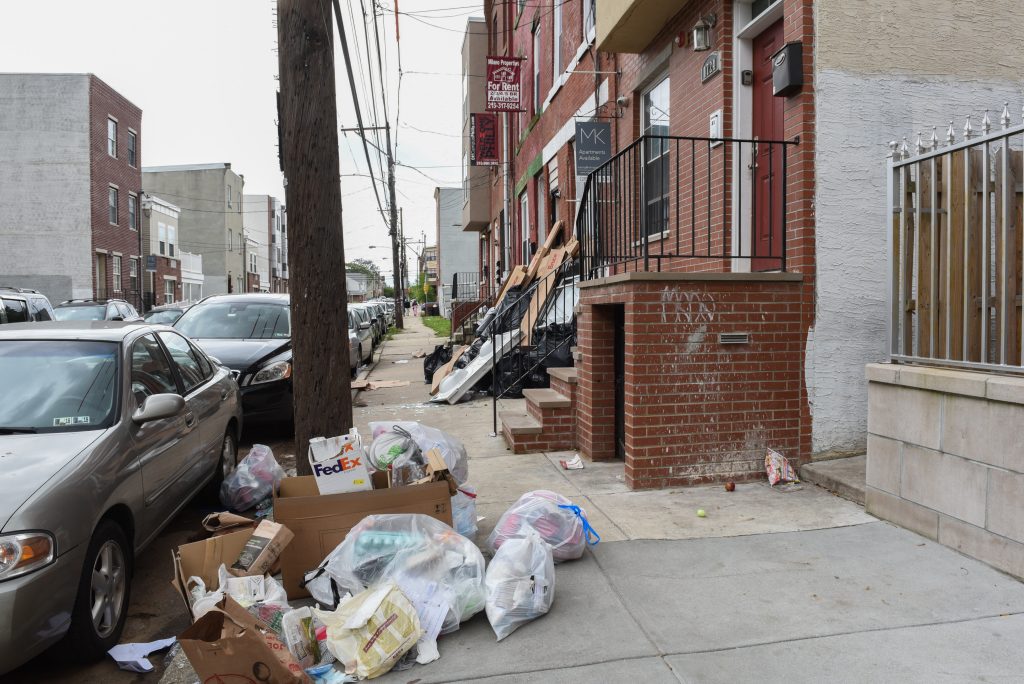
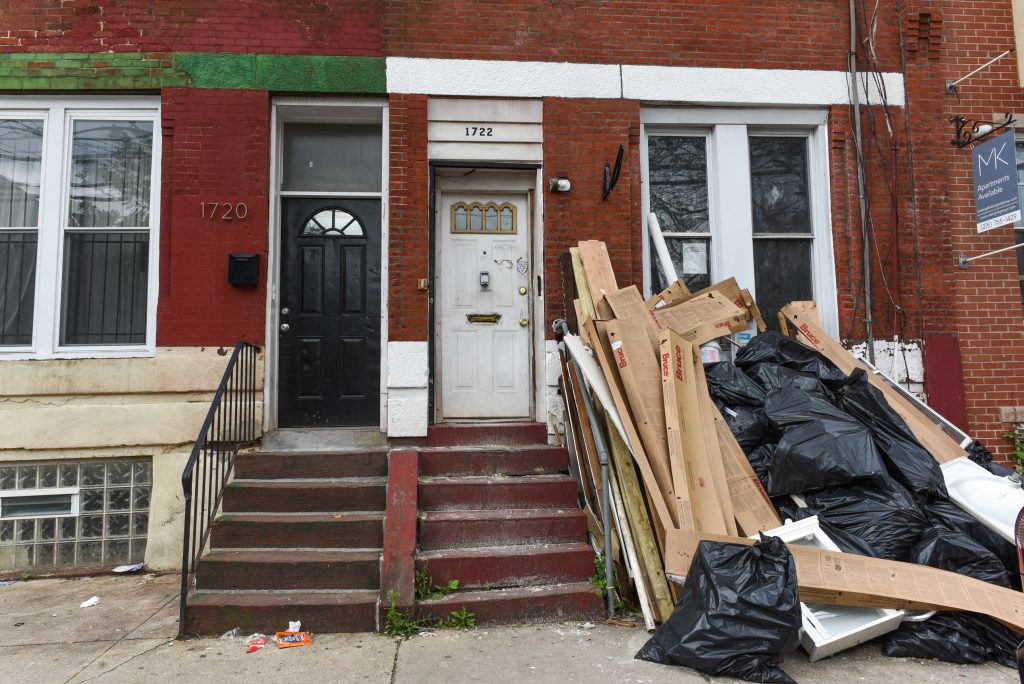
Construction waste is left outside of a rental home on Norris Street near 18th. Trash day in the neighborhood near Main Campus, West of Broad Street, is on Monday. BRIANNA SPAUSE | PHOTO EDITOR
Often, when residents have an issue, they call Capt. Eileen Bradley, Campus Safety Services’ community liaison.
“I feel comfortable in this community,” Bradley said. “So if they have a problem, they’ll contact me. … A lot of the community, they’ll say, ‘Call Capt. Bradley.’”
Bradley and Charlie Leone, the executive director of Campus Safety Services, said trash is the biggest issue for many community residents.
Donna Richardson, the council president of Norris Homes on 11th and Berks streets, said Bradley has been “very supportive of the Norris community” for years.
Richardson and the residents of Norris Homes, however, have complained about some students throwing trash from their cars, leaving broken bottles after parties and urinating on their sidewalks. The Philadelphia Housing Authority project is nestled between the Temple University Regional Rail station and the eastern border to Main Campus.
“Temple has to demand [its students] to respect the surrounding communities,” Richardson said.
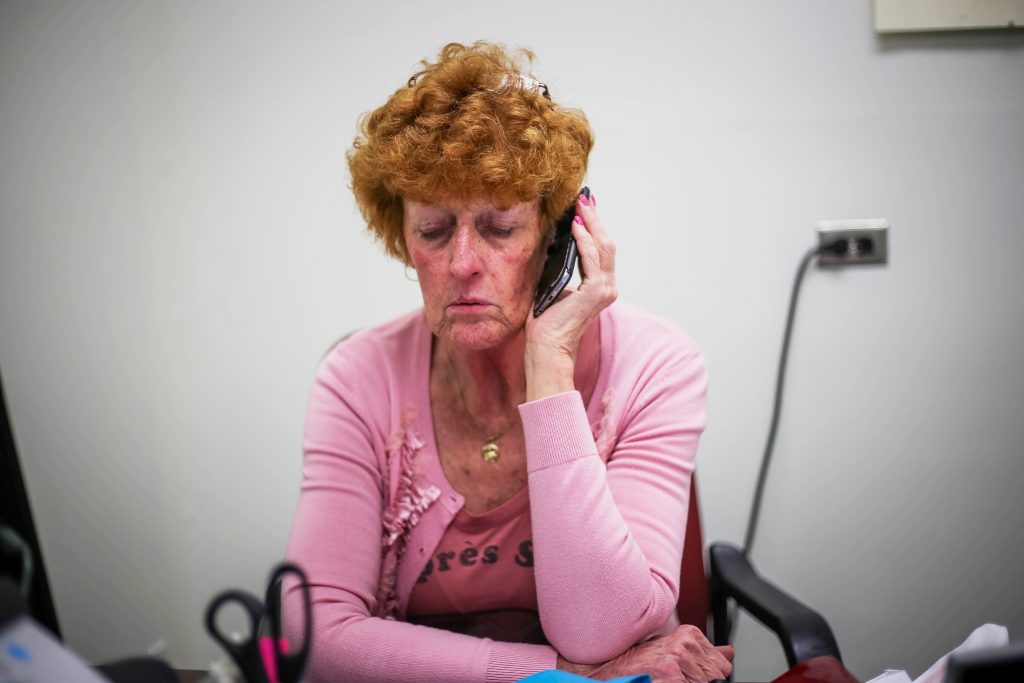
Capt. Eileen Bradley, Temple Police's community liaison, speaks to a resident on the phone. SHEFA AHSAN FOR THE TEMPLE NEWS.
Bradley also leads programs like Adopt-a-Block, in which student organizations clean up trash for an hour every Sunday on a specific block for a semester. Bradley supplies groups like the Temple chapter of the Lions Club — an international community service organization — with trash bags and supplies.
Joyce Wilkerson, Englert’s senior adviser for community relations and development, said Temple tried hiring trash haulers to collect trash left out between city pick-ups, but one of the city’s unions shut them down.
“We can’t just pick up trash because we end up running afoul of the city,” Wilkerson said. “Figuring how you get the resources mobilized to address some of these concerns could go a long way to really improve relationships.”
Wilkerson said Temple supported the Neighborhood Improvement District legislation proposed in 2012 and 2014 by City Council President Darrell Clarke, whose district includes Main Campus and surrounding neighborhoods.
The legislation would collect a fee from property owners to support a nonprofit organization that could hire people from the community to support initiatives like street cleaning and security.
The legislation, however, did not get support from the community because residents were concerned Temple was trying to take over the community, Wilkerson said.
The proposed 2012 legislation originally included language that would have given more voting power to Temple and landlords.
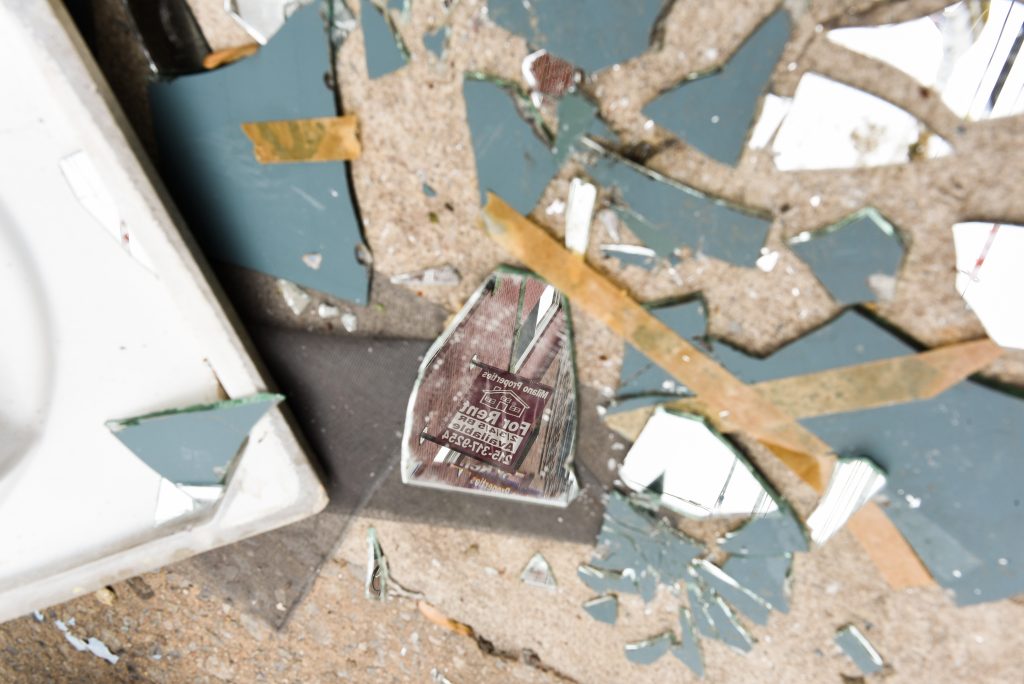
A “For Rent” sign can be seen in the reflection of broken glass that litters the ground on Norris Street near 18th on Saturday morning. Trash day in the neighborhood near Main Campus, West of Broad Street, is on Monday. BRIANNA SPAUSE | PHOTO EDITOR
Wilkerson said she thinks this type of legislation has the potential to offer a “coordinated response” to some of the challenges in the neighborhood.
Vice President of Public Affairs Bill Bergman said the university tried to talk to students about trash through programs like the Good Neighbor Initiative, a committee that encourages relationship building and links students with civic resources like trash-collection schedules. But his conversations with students “really [have] not worked,” he said.
He and Leone said to combat the issue, Temple Police issues Civic Violation Notices to households and the landlords of the properties, most of which are rented by students.
According to data from Leone, TUPD issued 84 CVNs for quality-of-life issues between August 2016 and April 2017. More than half of the CVNs were trash-related, while the rest were a result of excessive noise.
Last year, in response to complaints about student partying, Temple raised the fine for hosts of parties who were charged with underage drinking. The people named on the lease of a house would be fined up to $1,500 each.
The excess of trash and house parties near Main Campus was discussed by residents and administration over the course of our reporting this project.
Both parties expressed concern over student conduct off campus and the desire to hold them to high standards of behavior. While residents can file complaints with university personnel about misconduct, the students are ultimately responsible for their own actions.
“There is that competing interest there,” Sean Killion, an associate director in the Office of Residential Life said last month about the relationship between students and longtime residents. “What’s the university’s responsibility? … What is the students’ responsibility?”
There are offices and programs in place at Temple to aid the relationships between students and community residents and to facilitate a better relationship between the university and the community as a whole. Temple also offers many programs that provide services or education directly to community residents.
But these offices don’t operate under one umbrella, and they’re headed by different administrators. Over the years, they have moved locations and lost space. While some residents told The Temple News that they utilize these resources, others didn’t know how they’d access them if they wanted to.
OFFICE OF COMMUNITY RELATIONS
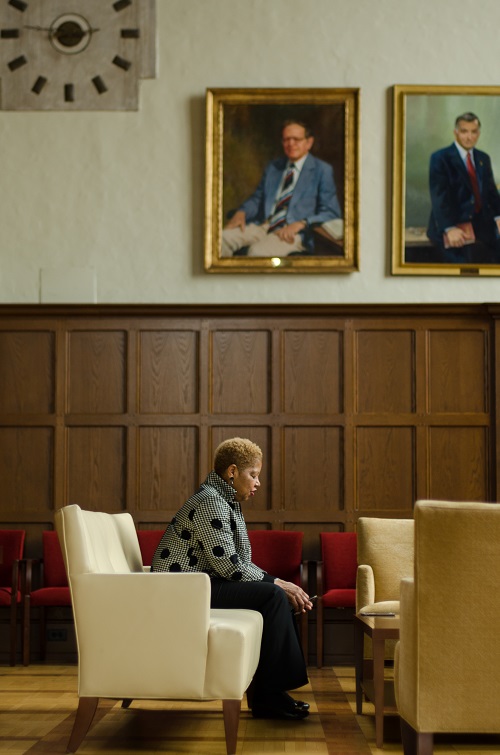

Joyce Wilkerson (left) is the senior advisor to the president for community relations and development at Temple. Andrea Swan (right) is the Director of Community and Neighborhood Affairs in the Office of Community Relations. GENEVA HEFFERNAN | ASST. PHOTO EDITOR
The university’s main point of contact with the community is the Office of Community Relations, headquartered on the second floor of the Entertainment and Community Education Center on Cecil B. Moore Avenue near 15th Street. The center, which opened in 2004 under former President David Adamany, also houses 90.1 WRTI-FM and Temple’s Pan-African Studies Community Education Program.
The office’s community outreach began as on-the-ground conversations between residents and Tom Anderson, the first director of community relations, when the office was established in 1973.
Today, there are four full-time employees in the office.
Director of Community and Neighborhood Affairs Andrea Swan, who started in 2009, works on community outreach, communicates with elected officials and oversees some of the 300 community outreach programs at Temple.
She considers the office a point of contact for “residential stakeholders,” but said she always makes sure to call them “our neighbors.” Swan also speaks with block captains, landlords and tenant associations, she said.
Southeast of Main Campus, she works with the Yorktown neighborhood, Norris Homes and Jefferson Manor, an affordable housing development from the city. Swan said her connection north of campus is not as established because many community leaders have died and there aren’t strong homeowners’ associations. It’s difficult to reach community residents west of campus because of the student population, Swan said, but she often makes contact with block captains, faith-based organizations and churches.
The university added efforts to recruit high school students from surrounding neighborhoods in 2011. To bring these students to the university, the Temple 20/20 partial scholarship program was created for students living in surrounding ZIP codes. She said there aren’t many formal requirements for the scholarship other than maintaining a 3.0 GPA.
“I have encouraged [those] students to see me as a resource,” said Swan, who connects with the students. “I cry whenever one of our kids graduates.”
In July 2016, Temple produced its first Community Resources Guide to inform North Philadelphia residents and the Temple community about the resources available to them, including those offered by Swan’s office.
Wilkerson said the guide helped consolidate information about programs.
“People within the university don’t know what the university’s doing,” she said. “And I think the brochure is a nice start, [but] there’s more of an initiative I think that the university might be able to undertake.”
The Office of University Communications issued the second Community Resources Guide to churches, offices of elected officials and residents who contacted Temple asking about its services in the past. The guides, which will be produced twice a year, are the university’s sole attempt to centralize resources for neighborhood residents. But because the guides are distributed to established community organizations Temple already interacts with, some who are not currently involved might be excluded.
Read more community reporting here.
Swan said she and her team go out in the community with flyers and their business cards because they know not all North Philadelphia residents have smartphones or use social media.
“You can’t let people know about Temple when you are behind a desk,” Swan said.
But some residents are not aware of the Office of Community Relations and other community outreach programs from Temple.
Marjorie Lewis, who has lived at 17th and Berks streets for 20 years, and her former neighbor, Krystal Blackman, 25, said they had never heard of the Office of Community Relations, any of its resources or even Eileen Bradley.
Blackman said it may be helpful for the office to use posters to reach the older generations and the internet to reach younger people.
Lewis said she doesn’t mind the student population surrounding her home.
“For me, I’m just sitting here and seeing them walk back and forth,” she said. “I see them going to school every morning. They are pretty good to me. … They are nice people.”
THE OFFICE OF THE PRESIDENT
In August 2014, Temple hired Joyce Wilkerson, a former chief of staff to former Mayor John Street and Street’s aide in the 1990s when he was city council president trying to fight the construction of the Liacouras Center at Broad Street and Montgomery Avenue.
Within the Office of the President, Wilkerson works to create connections between Temple and the community by linking schools and colleges with projects around North Philadelphia.
Wilkerson said she often works with the College of Education, which also has a partnership with Norris Homes. The College of Education works with schools around the city by sending Temple students into classrooms and hosting events, like Edcamp with The Fellowship: Black Male Educators for Social Justice on May 6.
Wilkerson relies on her existing relationships to create connections between the university and the community. She cited her experience in the 1970s with Community Legal Services, an organization that provides free legal assistance to low-income Philadelphia residents, as an example.
In November 2016, Wilkerson re-entered a political role when she was appointed chairwoman of the School Reform Commission, which oversees the Philadelphia School District. She also serves on the Board of Directors at Project HOME, a nonprofit that seeks to alleviate poverty and homelessness.
“I was at [Clara Barton Elementary School] recently,” she said. “The elementary school had no playground, so I reached out to some folk at Tyler and said, ‘Any chance, you guys would be able to help the principal, who’s short-staffed, put together a proposal for a playground?’”
“As I move around, it’s trying to both provide resources to the community, but also experience for students at Temple,” she added. “So it really is a mutually beneficial relationship that can develop.”
But Wilkerson said bringing the university and community together shouldn’t rely on her social network.
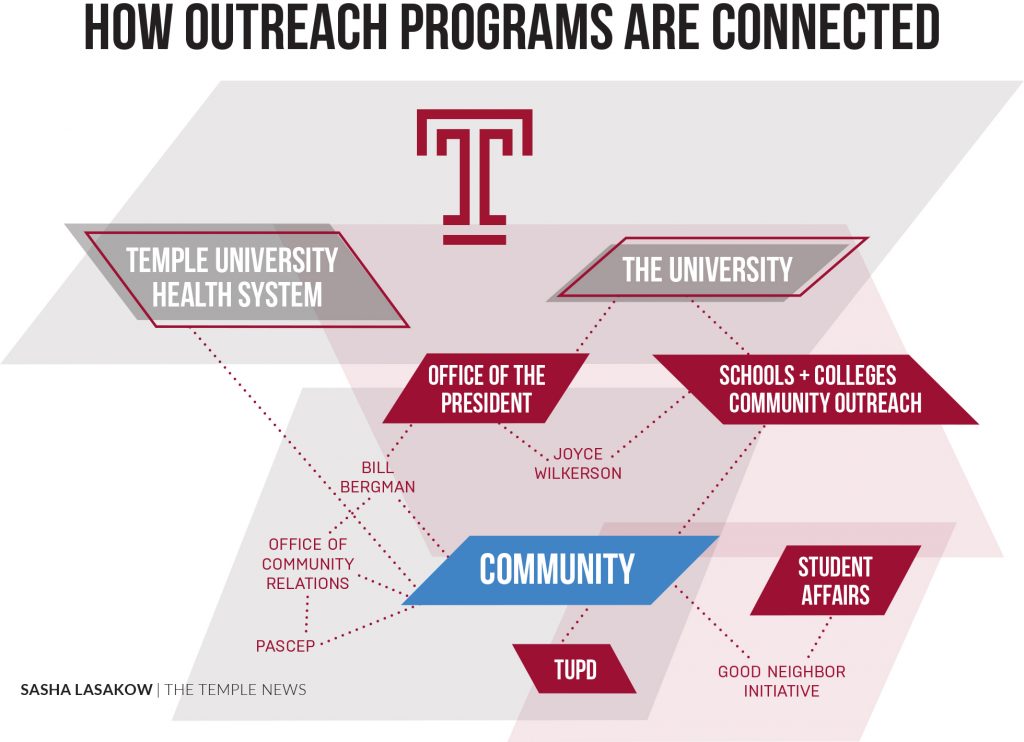
“I’m moving around, I have a lot of relationships, but I think there probably needs to be a more formal structure around it,” she said. “I’ve been in meetings where people say, ‘We just don’t know who to call or how to really connect.’”
Wilkerson said other local universities have community outreach centers that allow them “to better leverage their resources.”
The University of Pennsylvania engages in service, academic outreach and community development in West Philadelphia through its Netter Center for Community Partnerships, which was founded in 1992. Drexel University’s Dornsife Center for Neighborhood Partnerships, founded in 2012, connects its schools and colleges with nonprofits to support the “health, wellness and stability of the surrounding neighborhoods.”
Temple’s efforts are more disjointed, she explained. Penn and Drexel use their centers as the main access point to resources for health, education and the arts. Temple does not have a main access point. Instead, it links residents to sources within each school for residents to contact independently.
“We don’t know what we’re doing,” she said. “We don’t know what different people in the university are doing. All together it’s very impressive, but my guess is it could be more substantial.”
“I don’t think we get the credit a lot of time because we’re not easy to access,” she added.
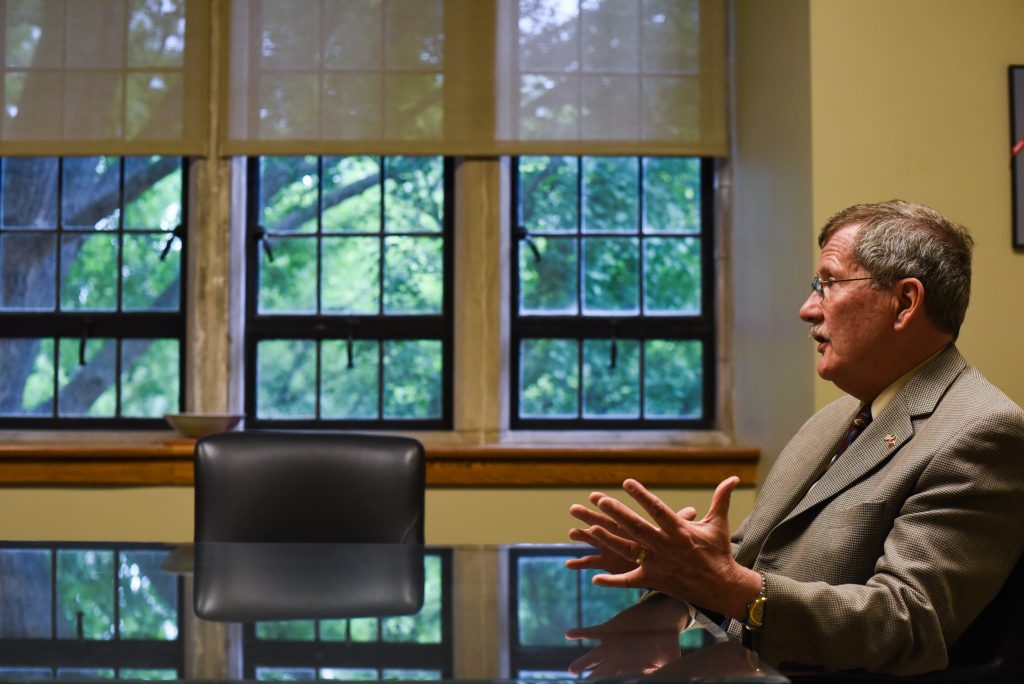
President Richard Englert doesn't believe community outreach should not be centralized. BRIANNA SPAUSE | PHOTO EDITOR
Twice per week, President Englert said he walks around Main Campus and the North Philadelphia community to better understand the neighborhoods surrounding Temple. He recently visited the Church of the Advocate on Diamond Street near 18th.
Englert said his office tries to “support, encourage and enhance” community outreach by making connections between Temple and North Philadelphia residents.
He believes a centralized structure for community outreach would restrict the many programs that schools and colleges create independently.
“The last thing we would ever need is to have everything [have] to come up to the president,” he said. “You kill innovation, you kill ingenuity, you kill local autonomy.”
GOOD NEIGHBOR INITIATIVE
In 2011, former President Ann Weaver Hart started a task force to address “rising concerns prompted by Temple’s growing residential population,” according to a university release.
It addressed behavior, safety and awareness issues among students living off campus and was made up of students, community residents and staff from Campus Safety Services, athletics, the Office of Community Relations and University Housing and Residential Life.
The Good Neighbor Initiative aims to continue the task force’s work. It’s chaired by Lauren Bullock, the Division of Student Affairs’ program director of leadership development, and Senior Associate Dean of Students Michele Goldfarb.
The Good Neighbor Initiative created a four-page document called the Good Neighbor Policy advising students to follow city codes and cooperate with neighbors and authorities.
It aims to “encourage positive relationships with community members … [and] gives special attention to issues of noise, alcohol consumption, trash and conduct.”
Goldfarb said students are responsible for living up to the policy, and students who violate it may have to go through a Student Conduct Board hearing.
Bullock said a Good Neighbor Initiative subcommittee is reviewing the policy to update it from its March 2011 version.
There are no North Philadelphia residents on the committee.
“We’ve talked about that before,” Bullock said. “But there’s never been a decision made either way.”
Both Swan and Bradley serve on the committee and share residents’ opinions with the committee, Bullock said.
Because Bullock and Goldfarb are new to the committee, they have spent most of this academic year focusing on data collection to better understand the issues and lapses in resources for students living off campus.
The group is working on an online survey that will be conducted through OwlConnect this month. The survey will gauge students’ awareness of trash collection schedules and city ordinances and collect information about off-campus life, like students’ experiences with landlords.
“For us, right now, our focus is on painting the picture of what the off-campus community looks like, including students,” Bullock said. “You hear varying perspectives and trying to get to what’s actually happening can be a challenge.”
Bullock said the committee’s focus is to teach students how to be good citizens and to provide them with resources to do so.
“And I think that in order to do that, you need to be able to learn about where you live, incorporate that into your daily life and into your education and also engage in some kind of service,” Goldfarb added.
WHAT THE UNIVERSITY CAN DO BETTER
President Englert said bringing together structure and function in terms of Temple’s various community outreach resources is an “ongoing challenge.”
“No organization’s structure and function is perfectly aligned,” he said. “Function is continuing to develop based on mission.”
Others see room for improvement and expansion in their outreach.
This summer, Ulicia Lawrence-Oladeinde, the director of the university’s Pan-African Studies Community Education Program, is going to start workforce development training for students as well as offering courses this summer.
She said overall, the university’s human resources department does a “great job” at preparing community residents for jobs at Temple, but job prospects are limited.
“How many front line workers can you need?” she said. “You know, you need more skilled workers and that’s the thing, helping people get the skills that they need to get different jobs.”
Temple employs 760 community residents from the immediate area surrounding Temple, said Ray Betzner, a university spokesman. Both Sodexo and Allied Universal Security Services employ 40 percent of their personnel from ZIP codes surrounding Temple.

FINNIAN SAYLOR | THE TEMPLE NEWS
In addition to increasing job opportunities for community residents, Richardson would like to see the university become more inclusive of the community.
“I wish they would open up and invite the community more with Temple events, instead of saying it’s just a Temple event,” she said.
“When [they] walk through Temple as a member of the community, they feel like an outcast,” she added. “But actually Temple has built around these people’s homes and makes them feel so unwanted.”
As members of the Good Neighbor Initiative prepare to survey students about off-campus life, the committee is also working to update its website to improve access to resources, like the Good Neighbor Policy.
“I’m grateful to what [Temple is] willing to do, but I pray that they will sit down and see what they can do more,” Richardson said. “And more doesn’t always mean financial. Sometimes more means sitting down and letting someone know their voice was heard.”
Julie Christie, Gillian McGoldrick, Erin Moran, Jenny Roberts and Emily Scott can be reached at news@temple-news.com or on Twitter @TheTempleNews.
Photos by Shefa Ahsan, Geneva Heffernan, Conor Rottmund, Emily Scott and Brianna Spause.
Videos by Rico Le, Abbie Lee and Linh Than.
Graphic by Donna Fanelle, Sasha Lasakow and Courtney Redmon.
Produced and designed by Donna Fanelle, Julie Christie, Gillian McGoldrick, Erin Moran, Jenny Roberts and Emily Scott.